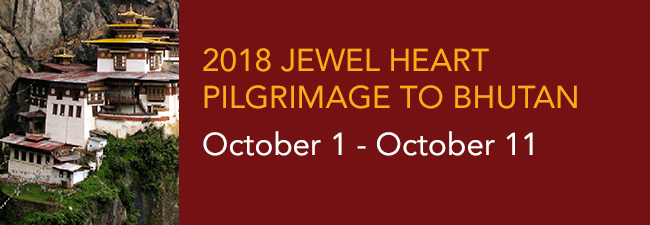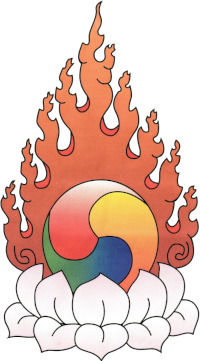
The Kingdom of Bhutan
Bhutan is officially called the Kingdom of Bhutan. It is bordered to the north by Tibet and to the south, east and west by India. In 2006 Bhutan was designated the eighth-happiest country in the world and the happiest country in Asia. Bhutan’s state religion is Vajrayana Buddhism. Buddhism was first introduced to Bhutan in the 7th century AD. by Tibetan king Songtsän Gampo, a convert to Buddhism. King Gampo extended the Tibetan Empire into Bhutan and Sikkim and built several important Buddhist temples.
After arriving at Thimphu Airport, we will proceed to our hotel, with a stop en route at the 14th century Tachog Temple, the hereditary place of worship for Bhutan’s great architect, Drupthop Thangtong Gyalpo (the builder of iron chain bridges). The temple stands at the base of a mountain across the Pa-chhu river on the Paro-Thimphu highway.
The second day starts with a visit to the National Memorial Stupa, built in memory of the Third King, Jigme Dorji Wangchuk, followed by visits to the 14th century Changangkha Temple, situated on a small hill top overlooking Thimphu valley, and to the Folk Heritage Museum, a showcase of Bhutanese artifacts used in rural households. Thereafter, we will visit the Mini Zoo to see the National Animal TAKIN, and the Zilukha Nunnery. We can do offerings of butter lamps and meet the Nuns at Zilukha Nunnery. After lunch, we will visit the Tashichho Dzong, the Kuensel Phodrang, and the Buddha Point – which has the biggest Buddha statue in the world, a beautiful figure on a hill top with a stunning view. We will also visit the School of Paintings Handicrafts Emporium, the Tibetan Medical Museum, Medicine Centre, the National Library, a paper factory, and Parliament House.
The next day we will visit the “108 Stupas” at Douchu-la, and will explore the Chimi Lhakhang, also known as Drukpa Kuenley Lhakhang. The Chimi Lhakhang is situated on a hillock in the center of the valley, and is dedicated to Lama Drukpa Kuenley. This Lama, nicknamed ‘The Divine Madman,” lived in the late 15th century, and was known to have used humor, songs, and outrageous behavior to dramatize his teachings. In this area we will also be visiting the ruins of Wangdu Dzong and Tsongsa Zong.
Our next stop on our trip shall be the town of Bhumthang, where we will visit:
Jambay Lhakhang: This monastery was built in the 7th century by the Tibetan King, Songtsen Gampo. It is one of the 108 monasteries built by him to subdue evil spirits in the Himalayan region.
Kurje Lhakhang: Situated in front of Jambay Lhakhang, Kurje Lhakhang consists of three temples. The one on the right was built in 1652 on the rock face where Guru meditated in the 8th century. The second temple is built on the site of a cave containing a rock with the imprint of Guru’s body and is therefore considered the most holy. The third temple was built in 1990s by Ashi Kesang, the Queen Mother. These three temples are surrounded by a 108 chorten/stupa wall.
Tamshing Lhakhang: Located across the river from Kurje Lhakhang, this temple was founded in 1501 by Terton Pema Lingpa, the re-incarnation of Guru Padsambhava. The monastery has very ancient religious paintings like 1,000 Buddhas and 21 Taras (Tara is the female form of the Bodhisattva Avaloketeshvara). The temple was restored at the end of the 19th century.
Jakar Dzong: Founded by the great grandfather of the first Shabdrung, the Dzong was initially built as a monastery in 1549. It was expanded after the Shabdrung had firmly established his power in 1646.
Konchogsum Lhakhang: This Lhakhang was built in the 6th century but was renovated in 1995, which accounts for its fresh look. It contained a large bell. It was said that when this bell was rung, it could be heard all the way to Lhasa, Tibet. The bell is now displayed at the National Museum in Paro.
Chankhar Lhakhang: This is the site of the palace of the Indian King Sindhu Raja. Because of its simplicity it looks like an ordinary village house. The original palace was built of iron and this is why it was named Chankhar, which means iron castle. It was rebuilt in the 14th century by a Saint named Dorji Lingpa.
Lhodrak Kharchhu Monastery: This monastery was founded by Namkhai Nyingpo Rinpoche in 1984 who was recognized at a very young age by H.H. the 14th Dalai Lama and H.H. 16th Karmapa as the reincarnation of an important Tibetan lama whose spiritual lineage dates back to the 9th century. The monastery now houses nearly 400 monks and has become part of an extensive effort to preserve and revitalize Tibetan culture.
We next arrive in Paro, to visit Taktsang, which is also known as “The Tiger’s Nest”. We will hike up to Taktsang to visit the oldest monastery in Bhutan built by Guru Padmasambhava. Later in the day, we’ll visit Ta-Dzong, Bhutan’s national museum. If time permits, we will visit Kyichu Lhakhang, another old monastery, built in the 7th century by King Thrisongdetsed, Dungtse Lhakhang, and Paro Farm House.
The group will then go on an excursion trip to Haa Valley via Chele-La Pass (3988 m), which is the highest motorable road in Bhutan. Haa Valley was closed to foreign visitors before 2001 due to the presence of the Indian Military Training Camp Center. On arrival at Haa valley, we will visit Lhakhang Karpo (White temple/chapel) and Lhakhang Nagpo (Black temple), built by the Tibetan King Songsten Gampo in a single day during the 7th century. Presently Lhakhang Karpo is the official residence of Haa monastic body. The Haa Wangchuklo Dzong, which was built in 1913 after the Dumchog Dzong was razed to the ground by fire, is also worth visiting. Haa Town has been developed along the Haa Chu River and can be divided into two distinct sectors: the Northern part of town has the central market, main shops and restaurants, while the Southern half of town is occupied by an IMTRAT (Indian Military Training Team) camp and a Bhutanese army training camp. Chhundu Lhakhang is one of several temples dedicated to the Haa valley’s protective deity, ‘Ab Chhundu’. In addition, the 8th Century Juneydrak Hermitage, a Cliffside retreat that contains the foot print of Maching Labdrom (1055-1132), a female Tibetan yogini, student of the famous master Phadampa Sangye (1045-1117), is a one hour hike uphill from Katsho village.
The price will be all-inclusive (lodging, meals, and local transportation) within Bhutan from October 1st through October 11, 2018.
The price also includes a donation of $1000 per person to the Jewel Heart Organization, which is tax deductible to the extent permitted by law.
The price for “Pilgrimage to Bhutan and India Tour” package does not include international airfare.
|
Lodging |
Single |
Per person for Double accommodation rate |
|
$6,400 |
$5,750 |
The package rate is based on a minimum of 10 persons for this trip.
All participants are expected to purchase their own health insurance and trip cancellation insurance, and will be asked to sign a waiver.
Contact: [email protected] Phone (734)994-3385
You can also visit: https://sites.google.com/site/jhpilgrimagebhutan2018/home


